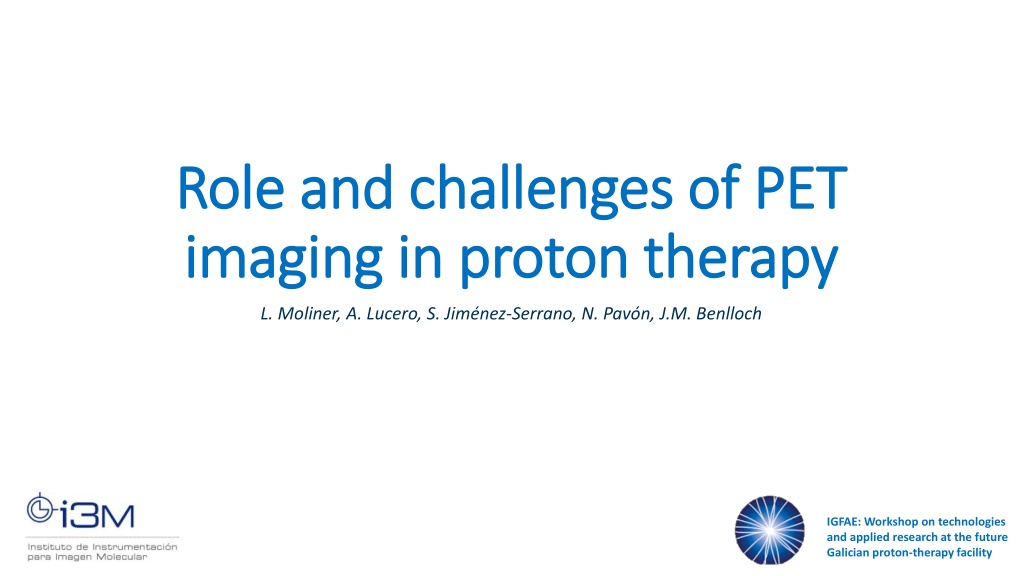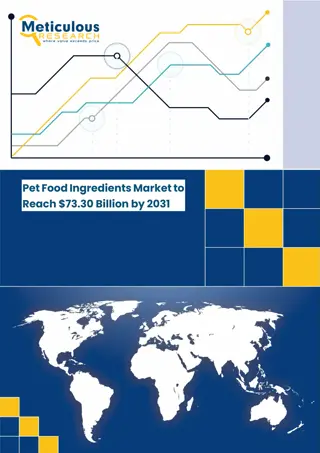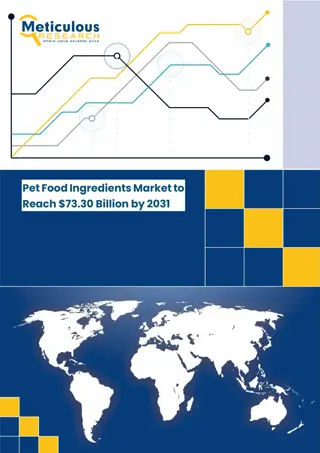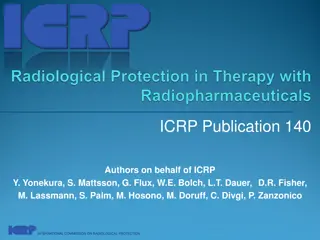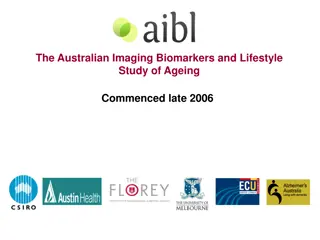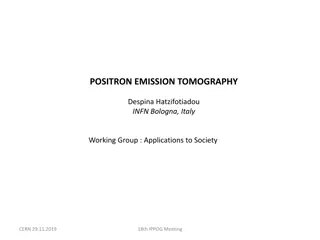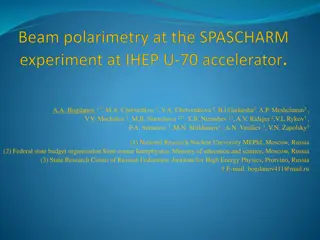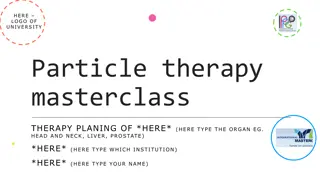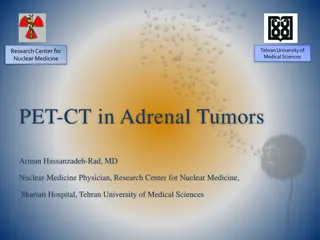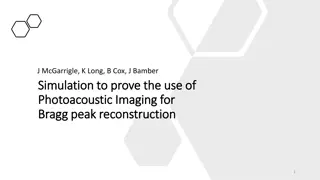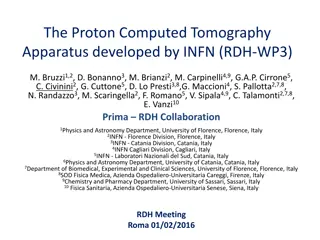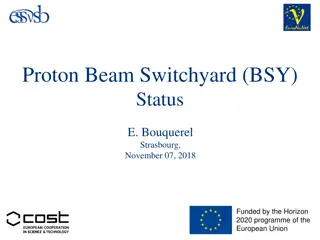Role and Challenges of PET Imaging in Proton Therapy
PET imaging plays a crucial role in proton therapy by aiding in range verification and monitoring treatment delivery. Proton therapy offers precise tumor targeting but is sensitive to uncertainties, making accurate imaging essential. Positron emitters generated during therapy can be detected using PET cameras to create images of radioactivity in tissues. Comparing measured and simulated PET data helps verify proton range. This technology presents challenges related to treatment planning accuracy and ensuring optimal dose delivery.
Download Presentation

Please find below an Image/Link to download the presentation.
The content on the website is provided AS IS for your information and personal use only. It may not be sold, licensed, or shared on other websites without obtaining consent from the author. Download presentation by click this link. If you encounter any issues during the download, it is possible that the publisher has removed the file from their server.
E N D
Presentation Transcript
Role and challenges of PET Role and challenges of PET imaging in proton therapy imaging in proton therapy L. Moliner, A. Lucero, S. Jim nez-Serrano, N. Pav n, J.M. Benlloch IGFAE: Workshop on technologies and applied research at the future Galician proton-therapy facility
Index o Introduction o PET Imaging in ProtonTherapy o Open Imaging project proposal o Results o Conclusions IGFAE: Workshop on technologies and applied research at the future Galician proton-therapy facility
ProtonTherapy Proton therapy has the ability to deliver a highly conformal dose to tumors. However, proton therapy is also more sensitive to uncertainties in treatment planning and delivery compared to photon therapy. A range error could mean a portion of a tumor not receiving any radiation dose at all (under-shooting), or the normal tissue lying distal to the beam receiving a full dose (over-shooting). Proton range inaccuracy is particularly of concern. https://gordon.mgh.harvard.edu/gc/research/pet-monitoring-of-therapy/ IGFAE: Workshop on technologies and applied research at the future Galician proton-therapy facility
ProtonTherapy During proton therapy irradiation, several positron emitters are produced in the living tissue from the interactions of protons having the main interest 11C and 15O with half-lifes of approximately 20 and 2 min, respectively. In therapy, therefore, PET cameras may be used to detect the emitted photons from the positron radioisotopes produced during proton therapy and create an image of the radioactivity generated. Atom Reaction Isotope t1/2 (min) 2,037 16O 15O p,pn 12C 11C p,pn 20,39 14N 11C p, 2p2n 20,39 16O 11C p, 3p3n 20,39 16O 13N p, 2p2n 9,965 14N 13N p,pn 9,965 31P 30P p,pn 2,498 40Ca 38K p,2pn 7,636 Several positron emitters produced inside the different tissues of the human body when it is irradiated by protons IGFAE: Workshop on technologies and applied research at the future Galician proton-therapy facility
PET in ProtonTherapy PET images in proton therapy are used to perform range proton verifications. TP_dose: Treatment planned dose MC_dose: Simulated dose MC_PET: Simulated PET Meas_PET: Measured PET In vivo PET range verification relies on the comparison of measured and simulated activity distributions. Chul Hee Min et al., Clinical Application of InRoom Positron Emission Tomography for In Vivo Treatment Monitoring in Proton Radiation Therapy, Int J Radiation Oncol Biol Phys, 86 (1), 2013 IGFAE: Workshop on technologies and applied research at the future Galician proton-therapy facility
PET in ProtonTherapy PET images in proton therapy are used to perform range proton verifications: Off-line PET, in-room PET, in beam PET Off- line PET, usually an established scanner in a nearby location It does not require capital investment. Usually includes anatomical information (PET/TC). It has no impact on the patient throughput in the treatment room Relatively long delay for PET acquisitions. Use of contrast has been proposed to increase the available positron sources generated (*) Affected by the biological washout 1. 2. 3. 4. Energy room Proton therapy system Treatment room Control room First center of Spanish proton therapy (Quiron, Pozuelo de Alarc n) Patient repositioning IGFAE: Workshop on technologies and applied research at the future Galician proton-therapy facility * Espa a, S., S nchez-Parcerisa, D., Bragado, P.et al. In vivo production of fluorine-18 in a chicken egg tumor model of breast cancer for proton therapy range verification. Sci Rep 12, 7075 (2022). https://doi.org/10.1038/s41598-022-11037-7
PET in ProtonTherapy In-room PET, positioned within the treatment room A full-ring detector can be used for complete data. Less delay between treatment and PET scan. Complications caused by biological washout, repositioning errors, anatomical changes, etc., are greatly reduced or eliminated. Has a relatively higher impact to the patient throughput in the treatment room. Complicated co-registration PET images and treatment planning CT scan. Chul Hee Min et al., Clinical Application of InRoom Positron Emission Tomography for In Vivo Treatment Monitoring in Proton Radiation Therapy, Int J RadiationOncol Biol Phys, 86 (1), 2013 Implies cost. IGFAE: Workshop on technologies and applied research at the future Galician proton-therapy facility
PET in ProtonTherapy In beam PET, detectors integrated into the beam delivery system PET acquisition can be started as soon as treatment stops or in pauses. For treatment sessions with multiple fields, a short PET scan can be taken after the delivery of each field. L. Boturra et al. Delivery and Range Monitoring in Particle Therapy in a Higly Innovative Integrated Design, Frontiers in Physics, 8, 2020 The PET activity level in the tissue is at the highest level. Effect of biological washout of PET activities is minimized. Patient repositioning errors and anatomical morphologic changes are avoided or minimized. Complex synchronization of the PET data acquisition with the beam control system. Expensive and technically demanding. Yamaya et al., "An initial investigation of open PET geometries," 2007 IEEE NSSCR, Honolulu, USA, 2007 Geometric constrains in a treatment environment. Full ring detector configuration is not feasible IGFAE: Workshop on technologies and applied research at the future Galician proton-therapy facility
PET in ProtonTherapy In beam PET Challenges Open Geometry Artifacts. Low sensitivity . https://the10ps-challenge.org/ Image quality, high resolution required for the application. Limited FOV Current instrumentation developments allows Time of Flight (TOF) providing an useful technique to reduce most of the precedents - Reduced artifacts - Increased SNR with same statistics J. van Sluis et al. "Performance characteristics of the digital Biograph Vision PET/CT system." JNM 60.7, 2019 - Allow high resolution reconstructions IGFAE: Workshop on technologies and applied research at the future Galician proton-therapy facility
Open Imaging PET (ERC-2022-POC1, European Commission) We are developing a proof of concept of a two-paddle PET system, which application is not only focused on therapy, but also on the possibility of using it for radiosurgery and in certain sectors of the population (patients with obesity, claustrophobia or mental illness). Our proposal is a PET detection system based on two pallets, close to the organ of study, with new detector technology to overcome as possible the limitations of open geometries: Large detection surface to maximize sensitivity and allow imaging of any organ. High resolution detectors. State-of-the-art TOF reducing open geometry artifacts and increasing SNR. IGFAE: Workshop on technologies and applied research at the future Galician proton-therapy facility Galician proton-therapy facility IGFAE: Workshop on technologies and applied research at the future
Open Imaging PET (ERC-2022-POC1, European Commission) 4 x 4 MODULES 256 mm 8x8 LYSO crystals 2x2x12 mm3 coupled to a 4x4 array of SiPM of 4x4 mm2 256 mm 4x4 SUPERMODULES (64x64mm2) Total: 32768 crystals IGFAE: Workshop on technologies and applied research at the future Galician proton-therapy facility Galician proton-therapy facility IGFAE: Workshop on technologies and applied research at the future
Open Imaging PET (ERC-2022-POC1, European Commission) o In order to have a cost-effective system the device will use row & column readout for each supermodule, reducing from 4096 to 512 channels for each pallet. o SiPM photodetectors, reducing electronic noise, allowing to work in room temperatures without liquid cooling. o On-module digitalization to increase temporal resolution accessing the information as soon it is available. o The digitalization is performed using the TOFPET2 ASIC from PETSys Electronics. IGFAE: Workshop on technologies and applied research at the future Galician proton-therapy facility Galician proton-therapy facility IGFAE: Workshop on technologies and applied research at the future
Open Imaging PET (ERC-2022-POC1, European Commission) The system has been simulated to evaluate the performance using GATE and different TOF resolutions using a distance between pallets of 280mm. Two reconstruction approaches: - MLEM using TOF bins - LMEM TOF Phantoms: - NEMA NU-2008 Image Quality - Derenzo Phantom Simulation data: - - Back-to-back. - 2mm pixel size. 11C and 15O as positron emitters. IGFAE: Workshop on technologies and applied research at the future Galician proton-therapy facility Galician proton-therapy facility IGFAE: Workshop on technologies and applied research at the future
Simulation Results NEMA NU2008 IQ Phantom. ListMode reconstructions (TOR projector, 10 iterations, 2mm pixel size, 1mm voxel size) 25ps 180ps Non-TOF IGFAE: Workshop on technologies and applied research at the future Galician proton-therapy facility Galician proton-therapy facility IGFAE: Workshop on technologies and applied research at the future
Simulation Results Derenzo Phantom (rod sizes 1.0, 1.2, 1.6, 2.4, 3.2, 4.0 mm). Binned TOF reconstructions (MLEM solid-angle projector, 20 iterations, 2mm pixel size, 1mm voxel size). ListMode reconstructions (TOR projector, 10 iterations, 2mm pixel size, 1mm voxel size). Radial Direction 25ps 180ps Non-TOF IGFAE: Workshop on technologies and applied research at the future Galician proton-therapy facility Galician proton-therapy facility IGFAE: Workshop on technologies and applied research at the future LM MLEM
Conclusions o The use of PET imaging for range verification in proton therapy requires a very demanding instrumentation. o Each PET imaging option (in-beam, in-room and off-line) has several advantages and disadvantages o The most important disadvantage for in-beam PET is the need of open geometries, but this limitation can be partially overcomed using time-of-flight devices, which are currently undergoing a high research activity, reaching about 200ps in commercial systems. o The Open Imaging Project is building a PET prototype based on two large pallets and time of flight capabilities, which is expected to have an spatial resolution of ~1.5mm and a TOF resolution of 180ps. Using this resolution the expected PET images will be suitable for in-beam PET imaging for range validation in the ProtonTherapy applications Thanks for your attention IGFAE: Workshop on technologies and applied research at the future Galician proton-therapy facility Galician proton-therapy facility IGFAE: Workshop on technologies and applied research at the future
Role and challenges of PET Role and challenges of PET imaging in proton therapy imaging in proton therapy L. Moliner, A. Lucero, S. Jim nez-Serrano, N. Pav n, J.M. Benlloch IGFAE: Workshop on technologies and applied research at the future Galician proton-therapy facility
